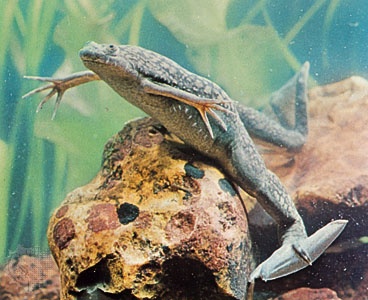clawed frog
amphibian
also called African Clawed Frog
 (genus Xenopus), any member of 6 to 14 species of tongueless, aquatic African frogs (family Pipidae) having small black claws on the inner three toes of the hind limbs.
(genus Xenopus), any member of 6 to 14 species of tongueless, aquatic African frogs (family Pipidae) having small black claws on the inner three toes of the hind limbs.Xenopus species are generally dull-coloured. Their bodies are relatively flat and bear whitish fringelike mucus canals that serve as sensory organs. When feeding they hang just below the surface of stagnant or slow-flowing muddy waters with outspread forelimbs, waiting for prey to pass by. Because they are tongueless, they rely on the forelimbs to guide food to their mouths, with additional aid from the rapid forward thrust of their powerful hind limbs. Considered among the more primitive species of frogs, Xenopus species have a simple egg-laying strategy: eggs are scattered individually over submerged vegetation.
Xenopus was once widely used for tests for human pregnancy because researchers found that young female clawed frogs would lay eggs when injected with minute quantities of a human hormone found in the urine of pregnant women. Though other types of pregnancy tests have since proved more reliable, Xenopus is still used in embryological and anatomical research.
One of the more important species is the platanna (X. laevis) of southern Africa, a smooth-skinned frog about 13 cm (5 inches) long. It is a valuable mosquito control because it eats the eggs and young of these insects. Native to sub-Saharan Africa, X. laevis was introduced to the United States and Britain.
- Henry William Blair
- Henry Williamson
- Henry William Stiegel
- Henry Willis
- Henry Wilmot, 1st earl of Richmond
- Henry Wilmot Richmond, 1st earl of
- Henry Wilson
- Henry Winter Davis
- Henry Woodfin Grady
- Henry X
- Henry Youle Hind
- Henríquez Ureña, Pedro
- Henschel, Sir George
- Henselt, Adolf von
- Hensen, Viktor
- Henshaw, James Ene
- Henslowe, Philip
- Henslow, John Stevens
- Henson, Jim
- Henson, Matthew Alexander
- Henze, Hans Werner
- Henzi, Samuel
- heparin
- hepatica
- hepatic vein